Duel to the Death (1983)
Directed by: Ching Siu-Tung
Written by: Ching Siu-Tung, David Lai, Manfred Wong
Starring: Damian Lau, Flora Cheong-Leen, Norman Chu, Shan Tinh
AKA XIAN SI JUE
HONG KONG
AVAILABLE ON BLU-RAY: 20TH SEPTEMBER, from EUREKA ENTERTAINMENT
RUNNING TIME:
REVIEWED BY: Dr Lenera
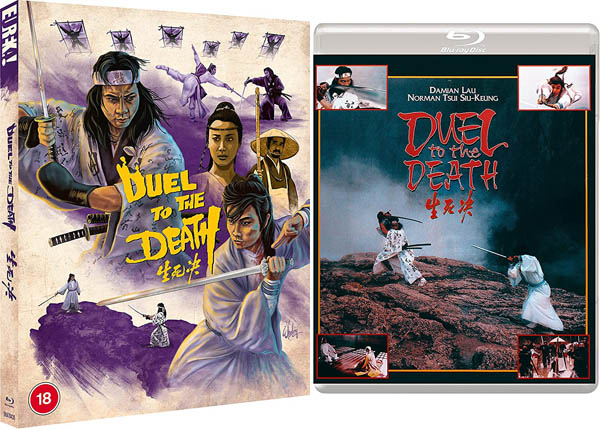
In the 16th century, every ten years the greatest swordsman from Japan faces the greatest swordsman from China in a duel to the death for their nation’s honour and to see which is superior. The chosen participants for the latest showdown are the Chinese Ching Wan, a peaceful and contemplative martial artist who’s trained with Shaolin monks, and the Japanese Hashimoto, a pitiless but honourable samurai. Meanwhile a group of ninjas break into the Shaolin Temple and copy down the contents of a manual about swordplay before hiding it when the monks surprise the intruders. A puppeteer is murdered right before Ching’s eyes. And a mysterious female seems interested in both Ching and Hashimoto. Could these things have anything to do with the upcoming fight?….
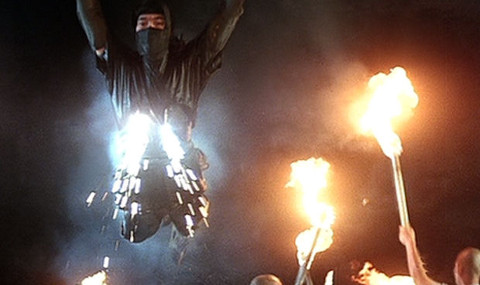
I never encountered Duel To The Earth in my early years as a Hong Kong movie fan where, like many others who were discovering this exciting brand of cinema, one often had to put up with video releases of dubious legality [even if they were sold openly in certain shops] and even more dubious subtitles. Despite coming from Ching Sui Tung who was later responsible for the Chinese Ghost Story, Swordsman and Heroic Trio films, not to mention doing the fight choreography for Zhan Yimou’s stunning trilogy of Hero, House Of Flying Daggers and Curse Of The Golden Flower, it’s clearly had much of its thunder stolen by Zu: Warriors From he Magic Mountain, a film that seems to be often regarded as the first in the cycle of wuxia films in which warriors were just as likely to glide around in the air [an attribute stemming from Chinese legends which often endowed skilled or powerful fighters with such an ability] as slice you with a sword, films that turned many of us into Hong Kong movie fans just as much as the daredevilry of Jackie Chan or the gun-fu of John Woo. But in fact Duel To The Death, which didn’t get released in the UK in any form for a long time, came just before and was much more the template for later offerings than Tsui Hark’s eye-popping fantasy. It’s still hardly realistic, yet it’s far less fantastical. Like Zu Warriors it manages to provide some commentary with the action, here discussing matters like honour and whether fighting has much point to it at all which is indeed a surprise in a genre which tends to celebrate it. While not as elaborate, flashy and ambitious, it’s stronger on actual fight choreography and plot. And if you like ninjas – well, you’ll be in heaven. You’ve got ninjas that appear out of trees, sand and water, that fly on battle kites, that explode, that are female and topless. There’s even a giant ninja who explodes into several normal-sized ninjas.
I’d love to give you some background information on this terrific hour and a half which really does deserve to be far wider seen and appreciated, but there’s little of it about – though I’m sure that there’ll be some elsewhere on this release. Still, I could easily spend several paragraphs just saying how cool scene after scene is and not talk about much else let alone – god forbid – criticise the thing. Sometimes if one is enjoying a film so much, one can be oblivious to or least not pay much attention to problems. Yep, if you haven’t guessed by now, I frickin’ loved Duel To The Death and don’t know how I’ve been able to survive without it for so long. When Crouching Tiger Hidden Dragon came out I kept on saying that, while it was undeniably good, I couldn’t understand the awe of so many critics seeing as Hong Kong had been making similar, if perhaps less artistically respectable, films for ages. And now, if I ever feel the need to say it again, this is the example I’m going to state. But I’ll try to provide a relatively sober review even though my mind is still filled with all these bad-ass moments that I want to describe to you. Like when Hashimoto man cuts one ninja from head to toe in one swing and stabs another one who jumps through his bisected brother. That man’s body explodes [some explode in this movie for a reason and some don’t, you’ve just got to go with it and if it annoys then you’re the wrong person for this movie] and the hero falls to the ground. Then Hashimoto stabs the ground, causing blood to fly out from a hidden ninja. But in thinking properly, this film is not only the link between the swordplay bloodbaths from Shaw Brothers and the airy fairy likes of Butterfly And Sword, but is also influenced by the Japanese chambara films, which is appropriate really and leads to something else that struck me – one of the two lead characters is not just Japanese but, in a far cry from the usual depiction, is treated with respect and sympathy!
So it’s nighttime – well actually quite obviously day for night but after a few minutes you won’t care. A shot of a temple – I have no idea if it’s supposed to be the Shaolin Temple or not but it doesn’t appear to be in the proper location – accompanied by a bell tolling and then an ear-splitting “WOOSH” takes us to the sight of loads of ninjas running towards the camera and quietly breaking into the temple to search for this certain scroll called the ‘Lost Manual on Breaking the Swordplay Stances of the Clans’. After copying it, some Shaolin monks interrupt them. “Amitabha Buddha be praised, I have been humbly waiting for you” says their leader before the mayhem begins, the camera often panning slowly down corridors taking in the action as it does. Even in his debut feature after working for some time on TV martial arts serials, Ching clearly knows what he’s doing, how to make his action look as good as possible, how to employ quick cutting and odd angles while still keeping things visually coherent which seems to be beyond some of the action directors of today. While all this is going on, some other monks are rooted to the floor praying. Ching wants to join in the fighting, but the others don’t want him to. He goes anyway, by jumping backwards through a wall [I wonder if he’ll later be punished for this?], and time is soon up for the ninjas, some of them doing their own version of suicide bombing after hiding the scroll because the copying procedure hadn’t been completed. You’d have thought that this would have been seen by one of the monks or found seeing as it’s in their garden, but never mind. “Winning is not a blessing, losing is a curse” says Bo’s uncle, the first of several similarly wise sayings which tell us that, maybe, all this spectacle we’re seeing doesn’t have a point to it and causes more bad than good.
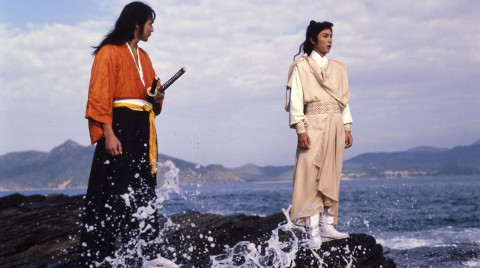
A Japanese envoy’s boast about being really good at Shaolin boxing is destroyed by Ching in the film’s only unarmed set-to. The duel is set up, and for a while we crosscut between the two fighters. Hashimoto has little interest in boozing and whoring before his journey, then is attacked by and kills someone who turns out to be his sensei, a samurai only becoming a master when he’s slain his master, which of course doesn’t make an awful lot of sense to us Westerners. Ching meets his own goofy old master [not drunken but clearly a nod to the recent wave of comedy martial arts films] who sports a terrible fake bald patch, bashes his head on trees when he leaps, and has a talking chicken. There’s a great scene showing a puppet act which stages the fight and has, of course, China vanquishing Japan and in an embarrassing manner too. The puppeteer is murdered and a lady fighter defeats the killers before Ching’s eyes. Her name is Sing-Lam, and she then finds Hashimoto and asks him to teach her. What’s her game? In a convention that we’d see in many films to follow, she’s supposedly disguised as a man though still looks like a woman to us, though, unlike in some successive wuxia films where other people hilariously can’t see this, she’s recognised for what she is immediately by one person. Is a montage, shot with soft-focus closeups, of her ‘becoming’ ‘properly’ feminine a jab at women who attempt to be too masculine? That might be reading too much into it, though it’s disappointing that Flora Cheong-Leen, like Michelle Yeoh a ballet dancer who easily transitioned into screen fighting, doesn’t participate in any action afterwards. There’s romance and more going on that I won’t reveal, including that exquisite murder method in You Only Live Twice which actually turns up a lot in chambara flicks. But suffice it to say that there’s villainy on both sides.
Despite the many “WOW” moments, this is not a series of fights connected by a few moments of marking time; this is a proper story featuring two main protagonists who we both like and who like each other but will eventually have to fight. The storytelling is clear and we’re not confused like in many ’70s traditional martial arts movies where one can easily lose track of who’s on who’s side. Of course the fighting has to be increased and we get a series of encounters that are both balletic and aesthetically beautiful to watch, yet which are shot so it looks like the participating performers are highly skilled [which some of them aren’t]. They also get increasingly bloody with lots of body parts being lopped off, and some of Hashimoto’s fight scenes are framed and staged in a Japanese style – again, very surprising in a Hong Kong film of this time, especially when one Hashimoto is still played by a Chinese actor, though things never get too formal for long as this is a film where, for example, two characters embark on the coolest way to get to a raft in a river from land you’ll ever see, and while we know it’s done with wire work and trampolines, the actors make it look effortless. The amount of wire work employed is huge and varied; it’s easy to forget how awkward and dangerous this could be for the actors. Damian Lau [who also appeared in Zu Warriors] is solid as Ching while Norman Chiu acts convincingly Japanese as Hashimoto. Casanova Wong turns up a few times and is allowed to shine. The romance could perhaps do with being expanded by a scene of two so we’re more emotionally involved in it, but nonetheless we do really care about the characters and their relationships, and are upset when few of them make it through.
Diverse camera angles enhance the varied settings, one of which has calligraphy on most of the walls, while even dialogue scenes sometimes employ odd edits without disrupting our involvement, though a few out of focus shots are noticeable. The drums of Michael Lai’s music score immediately make us picture Jackie Chan going into action, but the spaghetti western flavour of his two main themes is in keeping with the history of the genre, a history that this film is both paying homage to and subverting. An early conversation criticises but also admires the Japanese for their dogged perseverance, asks if these duels are “the way to resolve matters”, and suggests us that harmony can hardly be achieved by violence. A later line reminds us that only the “gods of death” are the real winners. No doubt conventions of the time still required that Hashimoto do something bad, but even then the script is strong enough that we understand his actions and don’t hate him. It’s both surprising and refreshing to get such an attitude, and by the time Bo and Hashimoto discuss the pitfalls of being a martial artist, namely that if you’re no good you’re soon be dead and if you’re good you’ll have to constantly accept challenges, Duel To The Death almost borders on being positively existential for the martial arts genre. This means that, by the time the ending comes along, we don’t know what to think. Is it celebrating these two fighters who’ll keep up going, who won’t give quarter no matter what? Or is it telling us how ridiculous they are, how futile their efforts are, especially in a world where bigger forces have been trying to effect and even control the outcome? You decide. One thing’s for sure though. Duel To The Death is a classic of Hong Kong cinema and a pretty wonderful, well balanced picture all-round.
Rating: 









SPECIAL FEATURES
Limited Edition O-Card slipcase featuring new artwork by Darren Wheeling [2000 copies]
1080p presentation on Blu-ray from a new 2K restoration from the original film elements
It’s come to the stage where there’s little point in me writing about the picture quality on these restorations that Eureka are using, because I’m just repeating myself. I can’t compare this one with previous releases as I never owned any, but this one is typically superb, with rich colours that often pop out at you and plenty of detail in the nighttime scenes. Unfortunately we can clearly see some wires towards the end which may not have been visible or as visible before, though it shouldn’t be a major problem. After all, so much of modern CGI is very obvious too.
Original Cantonese audio
Optional English dubbed audio
I switched over to this half way through and stayed the course with it; though done for a 1983 film it has some of the flavour of a ’70s traditional kung fu movie dub, meaning that I liked it a lot. Comparing at times with the English subtitles showed that they did a fairly good job of keeping the meaning of lines.
Optional English Subtitles, newly revised for this release (including correct translations for the Japanese characters, incorrect on all previous English language releases of the film)
Brand new feature length audio commentary by Asian film expert Frank Djeng (NY Asian Film Festival)
Djeng doesn’t disappoint with another packed and often scene-specific track where he only sometimes seems to pause for breath. We’re told that Korea substituted for Japan with much use of its similar architecture though of course Djeng points out the tell-tale difference, what the main influences for this film were, and even explain references and wordplay that only Chinese viewers would understand understand explained to us such as the line “too bad, this wine’s now ruined” being one often used in the writing of wuxia novelist Gu Long. Tseng comments on everything; the action, the cinematography, the acting. He finishes by apologising for talking too fast because he had to pack so much in. One of his best yet.
An Interview with Manfred Wong – an extensive interview with the screenwriter, covering his involvement in Duel to the Death and his illustrious and varied career in the Hong Kong entertainment industry [32 mins]
Damian Lau apparently declined to be interviewed while logistics scuppered talks with Chui and Chiu, but this interview with the co-screenwriter, with Tseng translating his comments, fills in a lot of background detail about the film. Wong, who was studying to be a TV writer then got pulled into writing for TV before he’d finished his course, and who even has the shooting script to hand, is very frank about Ching who was clearly hard to work with, though is still able to praise him, saying that his lack of education made him more creative. He also says how for ages he didn’t know how the story would end, but doesn’t remember how the eventual ending was decided upon, though he does Ching cutting some dialogue and adding for action. A balanced and honest interview.
Duel Identity – Archival interview with actor Norman Chui Siu-keung [19 mins]
This is the first of two interviews from the Hong Kong Legends DVD. They’re much shorter than the new one but contain very little repetition. Chui says how he was initially an accountant before he got bored and wanted to do something more exciting, how he’s usually been typecast as heroes in historical pieces and gangsters in modern films but has always wanted to play different role,s and how the lack of trees on the final cliff-edge location required the wires to be attached to eight stuntmen; if one fell off one of the edges, all plus the two stars may well have fallen to their doom as well.
Flora Cheung on Duel to the Death – Archival interview with actress Flora Cheung [9 mins]
Cheung tells of how she suddenly became wanted in the industry over night with offers coming left right and centre, how she was required to make so many films [ten!] in one year that she stopped acting and was subject to lawsuits, and the filming was hard but rewarding, her remembering being the only female performer who would often cry to get her way leading her to credit men as being more “clear and straight forward”.
Alternate English credits
Stills gallery 1 – production still
Stills gallery 2 – art work and ephemera
Original Hong Kong trailer
US Home Video trailer
A LIMITED EDITION collector’s booklet featuring new writing by James Oliver; and a reprint of Frank Djeng’s original liner notes from the US laserdisc release [2000 copies]
Breathtakingly exciting yet rather intelligent, ‘Duel To The Death’ is not just a quintessential wuxia film but a defining Hong Kong movie full stop. Eureka’s release therefore comes Highly Recommended.



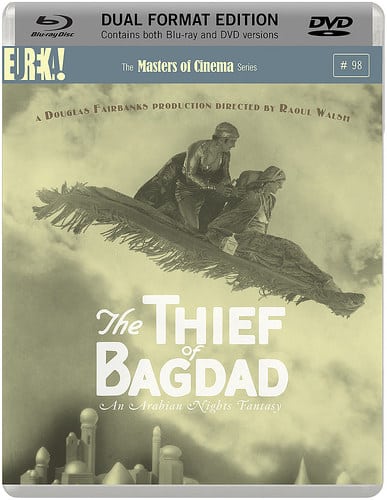
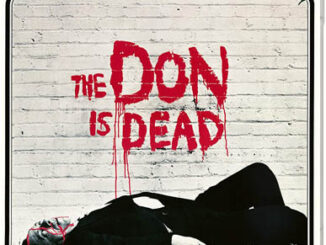
Be the first to comment